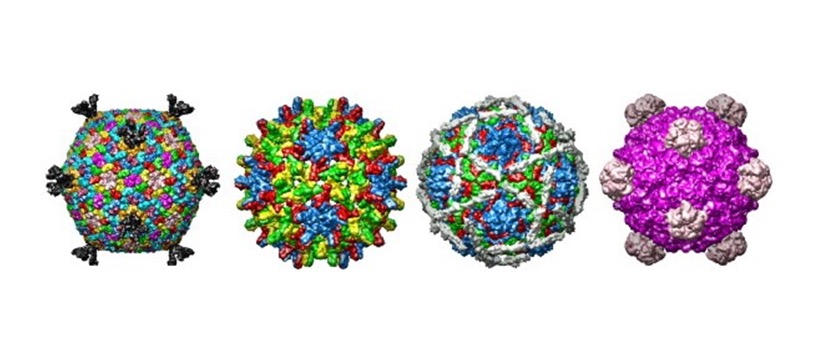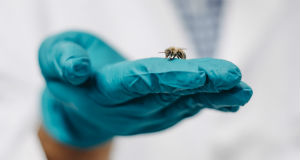Insect Virus Discovery
Next Generation sequencing technologies provide an outstanding resource for the discovery of insect virus-derived sequences. Genomes, transcriptomes and small RNA libraries provide evidence for virus-derived sequences in a given organism. Virus transcripts in combination with small RNA data and more classical virus discovery techniques can result in identification of both overt and covert viruses, of known and unknown classification. By using this technology, we have identified several new viruses in laboratory and field colonies of various insects, and also in insect cell lines. Such viruses may provide potential new tools for suppression of pestiferous insect populations or, in some cases, for the development of virus-induced gene silencing (VIGS) vectors.
Related publications
Nudivirus sequences identified from the southern and western corn rootworms (Coleoptera: Chrysomelidae). Liu S, Sappington TW, Coates BS, Bonning BC. Viruses 2021; 13(2), 269. doi: 10.3390/v13020269
Endogenous viral elements integrated into the genome of the soybean aphid, Aphis glycines. Liu S, Coates BS, Bonning BC. Insect Biochem. Molec. Biol. Aug 2020; 123:10345 doi: 10.1016/j.ibmb.2020.103405
Diabrotica undecimpunctata virus 2, a novel small RNA virus discovered from southern corn rootworm, Diabrotica undecimpunctata howardi Barber (Coleoptera: Chrysomelidae). Liu S, Valencia-Jiménez A, Darlington M, Vélez AM, Bonning BC. Microbiol Resourc Announc 2020 e00380-20. doi: 10.1128/MRA.00380-20
Genome sequence of a small RNA virus of the southern corn rootworm, Diabrotica undecimpunctata howardi Barber (Coleoptera: Chrysomelidae). Liu S, Valencia-Jiménez A, Darlington M, Vélez AM, Bonning BC. Microbiol Res Announc 25 Jun 2020; 9(26): e00379-20. doi: 10.1128/MRA.00379-20
The Insect Virome: Opportunities and Challenges. Bonning BC. Curr Issues Mol Biol. 2019 Jun 6;34:1-12. doi: 10.21775/cimb.034.001
Genome Sequence of a Novel Positive-Sense, Single-Stranded RNA Virus Isolated from Western Corn Rootworm, Diabrotica virgifera virgifera LeConte. Liu S, Chen Y, Sappington TW, Bonning BC. Genome Announc. 2017 May 18;5(20). pii: e00366-17. doi: 10.1128/genomeA.00366-17.
Genome Sequence of Diabrotica virgifera virgifera virus2, a Novel Small RNA Virus of the Western Corn Rootworm, Diabrotica virgifera virgifera LeConte. Liu S, Chen Y, Sappington TW, Bonning BC. Genome Announc. 2017 May 18;5(20). pii: e00365-17. doi: 10.1128/genomeA.00365-17.
Aphis Glycines Virus 2, a Novel Insect Virus with a Unique Genome Structure. Liu S, Vijayendran D, Chen Y, Bonning BC. Viruses. 2016 Nov 19;8(11). pii: E315. Viruses. 2011 Oct;3(10):1849-69. doi: 10.3390/v3101849. Epub 2011 Oct 10.
Genome Sequence of a Novel Iflavirus from the Leafhopper Graminella nigrifrons. Chen Y, Liu S, Bonning BC. Genome Announc. 2015 Apr 30;3(2). pii: e00323-15. doi: 10.1128/genomeA.00323-15.
Analysis of new aphid lethal paralysis virus (ALPV) isolates suggests evolution of two ALPV species. Liu S, Vijayendran D, Carrillo-Tripp J, Miller WA, Bonning BC. J Gen Virol. 2014 Dec;95(Pt 12):2809-19. doi: 10.1099/vir.0.069765-0. Epub 2014 Aug 28.
Lymantria dispar iflavirus 1 (LdIV1), a new model to study iflaviral persistence in lepidopterans. Carrillo-Tripp J, Krueger EN, Harrison RL, Toth AL, Miller WA, Bonning BC. J Gen Virol. 2014 Oct;95(Pt 10):2285-96. doi: 10.1099/vir.0.067710-0. Epub 2014 Jul 1.
Arthropod viruses and small RNAs. Vijayendran D, Airs PM, Dolezal K, Bonning BC. J Invertebr Pathol. 2013 Oct;114(2):186-95. doi: 10.1016/j.jip.2013.07.006.
Next generation sequencing technologies for insect virus discovery. Liu S, Vijayendran D, Bonning BC. Liu S, Vijayendran D, Bonning BC. Viruses. 2011 Oct;3(10):1849-69. doi: 10.3390/v3101849. Epub 2011 Oct 10.


 Honey bees and native bees play a pivotal role in pollination for production of many fruits and vegetables. Recent declines in honey bee populations have been linked to changing land use and a decrease in bee nutritional resources. In collaboration with
Honey bees and native bees play a pivotal role in pollination for production of many fruits and vegetables. Recent declines in honey bee populations have been linked to changing land use and a decrease in bee nutritional resources. In collaboration with